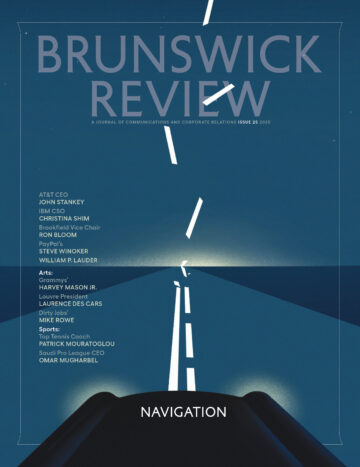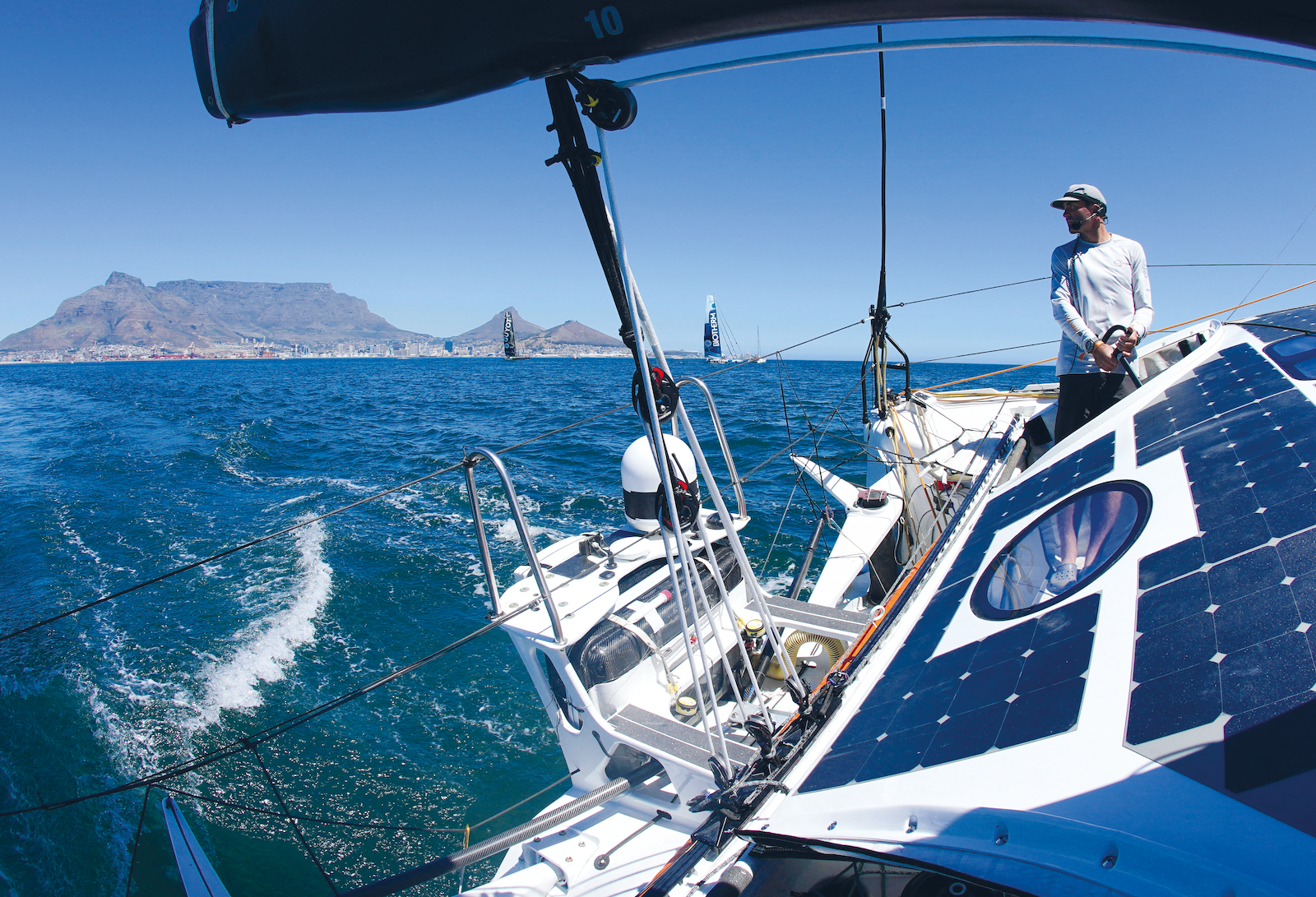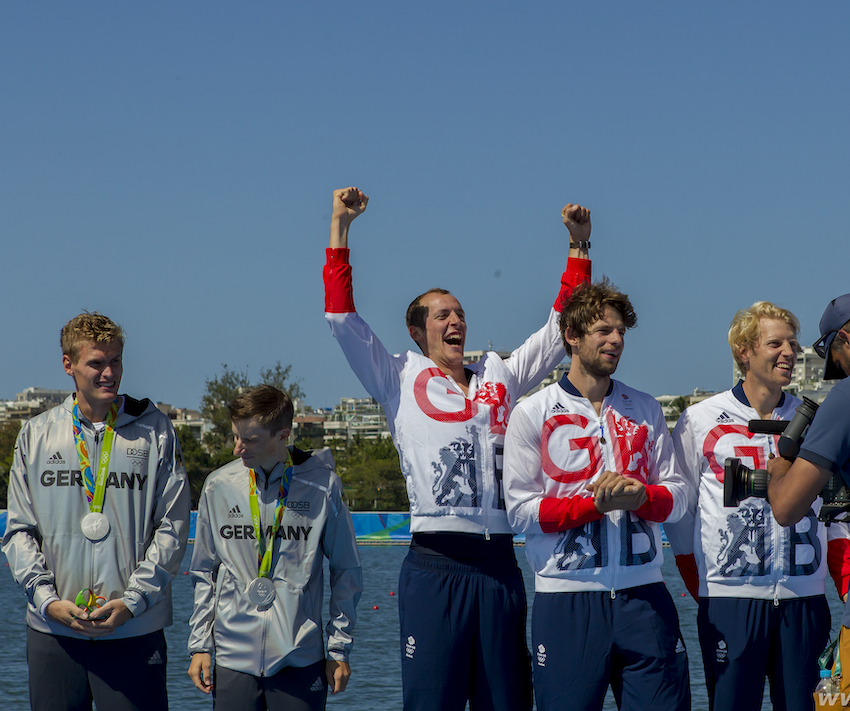The new CEO of the governing body of American sailing is no bureaucrat. Arguably, Charlie Enright is America’s most accomplished sailor. By Charlie Drayton and Cerith Evans.
Charlie Enright surveys Table Bay off Cape Town, South Africa, ahead of leading the first American team to win the Ocean Race.
In the 130-year history of the modern Olympic Games, sailing stands out as an American bright spot. The nation’s 62 Olympic sailing medals rank second only to Britain, a surprising performance in light of how far most Americans reside from any coastline.
In recent Olympic cycles, however, American dominance in the sport has waned. After winning only one medal at the Beijing 2008 Games, the US Olympic Sailing team has taken home only two more from all four of the subsequent Olympic competitions, hosted in London, Rio, Tokyo and Paris. Following last year’s disappointing performance, the latest in a series of leadership changes took place when a broad, months-long search led to the hiring of Charlie Enright as CEO of US Sailing, the sport’s American governing body.
All sailing fans need to know about Enright is that he won the 2023 Ocean Race—leading the first American team to do so. Its website notes that for nearly 50 years, the Ocean Race competition has had “an almost mythical hold over some of the greatest sailors.” The race claims to be known as “the longest and toughest professional sporting event in the world” and is one of sailing’s Big Three events, alongside the Olympic Games and America’s Cup.
“To truly understand the race, though,” the Ocean Race website says, “it’s better to think of it in a way the athletes who take part will recognise immediately. Put simply, The Ocean Race is an obsession, and many of the world’s best sailors have dedicated years, even decades of their lives trying to win it.”
Indeed, Enright’s victory came on his third try. Years of planning and training are behind each attempt. Then there’s the race itself, a round-the-world competition that takes five months to complete, exposing teams on every yacht to temperatures that range from freezing to boiling.
Enright led the 11th Hour Racing Team of about 10 men and women. In the wake of their victory, he told the press, “This race takes everything out of you—emotionally, mentally and physically. I’m incredibly proud of our whole team who have worked tirelessly for three years to get to this point. There have been highs, some incredible highs, but also lows that have knocked us all, but they were all worth it.”
A graduate of Brown University, Enright is a member of its Hall of Fame—award-winning team captain and Sportsmanship Award recipient, he led Brown to multiple small-boat sailing championships and top-five finishes in national sailing competitions.
Only weeks into his new role as US Sailing CEO, Enright isn’t yet keen on discussing his strategy for restoring America’s Olympic sailing glory, although the ’28 Los Angeles Games might provide some home-water advantage. The last time the Games took place in Los Angeles, US Sailing won seven medals.
In an interview with the Brunswick Review, Enright says that he intends to deepen the governing body’s commitment to increased popularity and inclusivity. Those efforts include the newly launched US Sailing Scholarship Fund, which will give opportunities to young sailors. The more that America’s youth falls in love with sailing, he reasons, the more candidates there will be for Olympic competition.
Enright also confides that he intends to lead by example. What could be more inspiring than to be led by America’s most accomplished sailor?
What drew you to sailing?
It’s one of those only-in-Rhode Island stories. I grew up in Bristol, Rhode Island, which is where the US Sailing Office is. My grandfather was a boat builder. That’s what got me into it.
I enjoy the feeling of being on the water and I’m a really competitive person. So once competition became the name of the game, it led to: “How can I do more? How can I do more, better?” And it just grew from there. I was competing on Narragansett Bay, and then in the blink of an eye, I was sailing around the world.
“What leaders are able to do effectively is create a culture within any team. That culture is ultimately what determines your success or failure.”
Was there a specific moment you can pinpoint where you thought, “this is what I want to do forever”?
There was a moment for me in 2007. While I was still at university, I was lucky to be part of a Disney-produced documentary. It was called Morning Light, and it was about a group of young sailors taking on the Transpacific Yacht Race from Los Angeles to Hawaii.
During that experience, we had a bunch of top-level coaches that had come from the professional sailing world. It was then and there that I realized what opportunities were out there.
The Ocean Race then became my aspiration. It’s the pinnacle prize of crewed sailing; that became the goal. It took three times, and 10 years of my life to ultimately achieve that. To think back on when I set out to do it, it’s a pretty amazing journey.
Did you always see yourself as the skipper?
When you exude leadership qualities, you become a natural leader. And what leaders are able to do effectively is create a culture within any team. That culture is ultimately what determines your success or failure.
What was the hardest moment you faced at sea? And what is your mindset when it comes to
navigating with your team under pressure?
I’ve seen a lot having sailed around the world three times. I’ve been part of dismastings in the Southern Ocean, boats colliding and I have even stopped to help a boat stuck on a reef in the middle of the Indian Ocean.
I spend a lot of time trying to dream up scenarios based on my experience and using my imagination. Even then, it’s still the things that you never see happening—that’s what gets you into trouble.
Sailing around the world puts you in very high-stress environments. But I think it’s important that you operate in those environments the same way you would any other. If you do your job the same every time, it lessens the sense of intensity that sometimes surrounds these situations.
I like to say that I’ve never been scared in any of the situations I’ve experienced. You always get what I call a heightened sense of awareness, which is a way of saying, “holy shit.” But whether the situation is intense or not, it shouldn’t change how you operate, or how you do things.
You’ve spent a lot of time in the water, what made you transition to wanting to take on the role as CEO of US Sailing?
I had been pining for this Ocean Race trophy for at least a decade, probably the better part of two. Having summitted my own personal Everest, it was time for a change and a new challenge.
A lot of what I’d been yearning for was selfish in some ways. And looking back on it, I’ve gained so much in my life from the sport of sailing. So, when this opportunity arose, it seemed like a really good chance to give back, and to share a lot of what I’ve learned with the broader sailing community.
“For me, all the races that I’ve done have been about the people and the places. You get to meet some unbelievable individuals in all corners of the world.”
What has surprised you the most so far?
There are a lot of similarities between what I did previously and what I’m doing now. People are people. A team’s a team. You have a goal you’re looking to achieve. I think that what has surprised me the most is probably just the breadth of the organization, and how many different things it is that we do.
We touch so many aspects of the sport. I came into it from my own perspective, but there’s so much more the organization does in different arenas. It’s been fun getting to learn about those and trying to figure out what we can do better.
What are you most focused on?
I’d say it is a bit of everything. Efficiency is the word that comes to mind. You can only have performance on the water if the operation is running efficiently behind the scenes. All the things that go into running a high-performance business will translate to results on the water.
Streamlining our processes and making sure we’re doing everything sustainably so we’re not having the same conversations year after year about how to achieve performance, how to grow the membership, how to grow the sport—that is a goal of mine.
There’s a honeymoon period where you’re trading off sentiment. But eventually we’re going to have to produce some results. Hopefully after the listening tour concludes and I believe I have all the information, we can draw some lines in the sand, deliver a coherent plan and nurture the growth.
The results are going to be down the road—that’s how it works with sailing campaigns as well. You build a boat for 16 months that you’re going to race in three years, and it evolves over time. The process is just starting.
There’s plenty of fires burning brightly in front of me every day. I constantly feel the need to zoom out and realize that it’s about the long term.
The Ocean Race was a single moment that you knew you had to achieve. Have you identified what that is for US Sailing?
I’ve never been much of a planner, to be honest. Part of what we do is present the Olympic team. We have a really great opportunity here with the LA games in ’28. In some ways, I’m thinking it’d be nice to be here through the Olympics in ’32, in Brisbane. Some of the decisions that we’re making today hopefully have ramifications past the ’28 games, and into the future.
I’d like to see the membership double over the course of the next three years. The development of the sport in this country is incredibly important. Sailing is a choice and it’s competing with a lot of other activities for our time. Nobody has to go sailing, right? So we must make a case for why they should, and share what it has brought us respectively, and what it has the ability to bring others in the future.
What is your message to a young athlete who’s considering sailing?
It’s more than a sport. It’s a lifestyle. For me, all the races that I’ve done have been about the people and the places. You get to meet some unbelievable individuals in all corners of the world. You get to do it from the time you’re 6 until you’re 60, and beyond. It connects you with an unbelievable part of our environment in the ocean, bays, lakes and rivers.
Are there any principles of navigating that you swear by?
When we navigate offshore it’s a simple process. We have what we call the performance polars of our boat, which is the predicted performance. And then we have the expected weather that we’re going to experience. You stick all that into some software, and it spits out a yellow brick road. That’s the science.
The art is figuring out why it’s not going to happen that way. Knowing what the pitfalls are going to be, why the information would be imperfect, what you’re really going to experience here versus there.
It’s this blend of art and science, not only navigating in the ocean, but navigating every scenario. There’s always the ideal utopian solution. But rarely does that come to fruition. It’s how you navigate the bumps along the way that gets you to where you’re going in the best possible fashion.
Is it the navigation aspect that hooks you the most about being on the water?
Navigation at sea is an intellectual challenge. That’s stimulating for me, sure. But what keeps me coming back is just the feeling of sailing through the ocean. It sounds kind of cliché, but we are so lucky to be able to do what we do.
To see the boat on a chart between two massive continents in the middle of nowhere is just this awesome, empowering feeling. You’re thousands of miles from anything. And it’s you and your teammates against the world. It can’t be understated, the high that provides for an adventure seeker like myself.
And you’ve never been scared?
To some extent, I’m wired in a way where I don’t get “scared.” The attitude with how you approach a challenge is intrinsic to you as a person.
I always remind myself, in any situation—people have done it before me. And people will do it after me. We’re really lucky to be doing what we’re doing. We just can’t lose sight of that.
More from this issue

Navigation
Most read from this issue

The Intentional CSO






